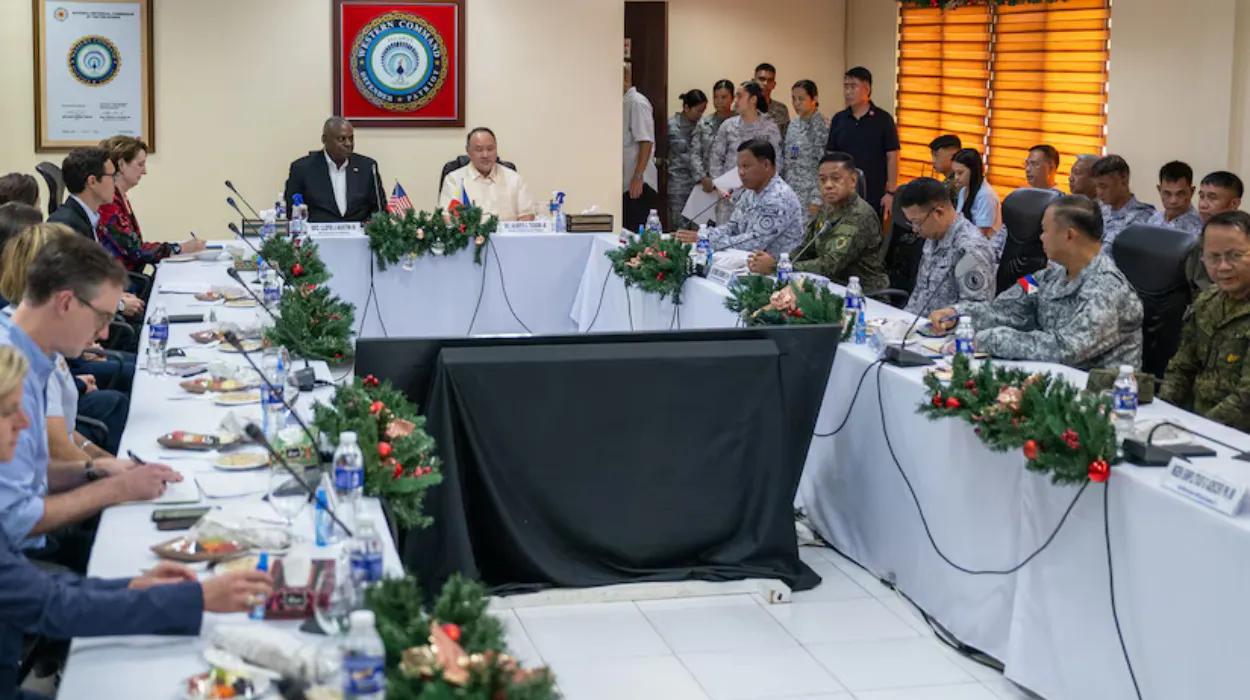Philippines (Transatlantic Today) – Defense Secretary Lloyd J. Austin III emphasized the United States’ unwavering commitment to the U.S.-Philippine Mutual Defense Treaty during his visit to the Philippines. This marks his fourth trip to the country since taking office, where he highlighted the expanding defense cooperation between the two nations.
Strengthening Ties in Palawan
During his visit to Palawan, an archipelagic province on the Philippines’ western edge, Austin and Philippine Secretary of National Defense Gilbert Teodoro toured Antonio Bautista Air Base, one of nine sites established under the Enhanced Defense Cooperation Agreement (EDCA). The agreement, signed in 2014, allows for greater U.S. military presence and cooperation in the region.
Austin and Teodoro also visited the Headquarters of the Armed Forces of the Philippines’ Western Command, responsible for overseeing efforts in the South China Sea. They observed a demonstration of T-12 unmanned surface vessels, key assets used by the Philippine navy to enhance intelligence, surveillance, reconnaissance, and maritime domain awareness capabilities within the Philippines’ exclusive economic zone. These unmanned vessels are part of the U.S. Foreign Military Financing program, which is designed to bolster Philippine defense capabilities.
Commitment to Philippine Defense
Austin reaffirmed the U.S.’s “ironclad” commitment to the defense of the Philippines, emphasizing that the Mutual Defense Treaty applies to armed attacks on either country’s forces, aircraft, or public vessels, including coast guards, anywhere in the South China Sea.
“The United States remains profoundly committed to ensuring that the Philippines has the necessary capabilities to defend its sovereignty,” Austin said in a press conference during his visit.
Key Agreements and New Initiatives
In addition to his visit to Palawan, Austin and Teodoro signed the General Military Information Agreement (GSOMIA), which enables enhanced information sharing and defense technology cooperation between the U.S. and the Philippines. This agreement is expected to further improve interoperability between the two forces and lay the groundwork for additional security agreements in the future.
Austin also participated in the groundbreaking of a new combined coordination center at Camp Aguinaldo in Manila, aimed at fostering more efficient information-sharing between U.S. and Philippine forces. This development reflects the deepening defense cooperation between the two countries.
U.S.-Philippine Military Relations Under Austin’s Leadership
Since taking office, Austin has played a pivotal role in expanding U.S.-Philippine military ties. Under his leadership, the U.S. and the Philippines have added four new rotational sites, bringing the total to nine, further strengthening combined training and interoperability between their armed forces.
Austin’s visit underscores his ongoing efforts to solidify U.S. partnerships in the Indo-Pacific, with the Philippines serving as a cornerstone of U.S. regional security strategy.
Continued Engagement in the Indo-Pacific
Austin’s trip to the Philippines is part of his broader regional engagement, which includes meetings with senior leaders throughout the Indo-Pacific. After departing the Philippines, Austin traveled to Laos to attend the Association of Southeast Asian Nations (ASEAN) Defense Ministers’ Meeting-Plus. At this forum, he plans to announce the first-ever Defense Department vision statement for a prosperous and secure Southeast Asia.
Austin’s final stop will be in Fiji, where he will meet with the Prime Minister and other officials to begin negotiations on a Status of Forces Agreement, further enhancing U.S.-Fiji defense cooperation.


























